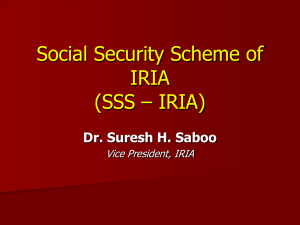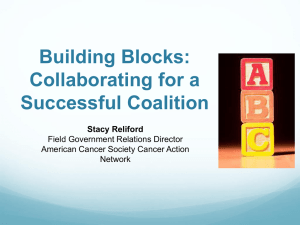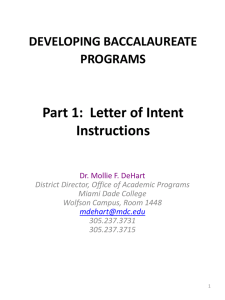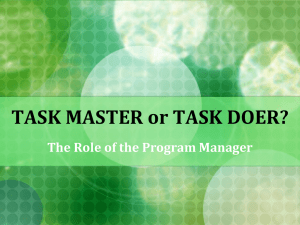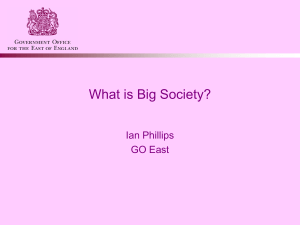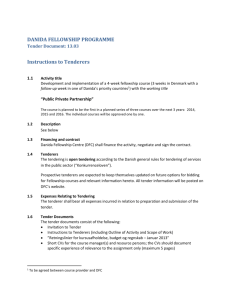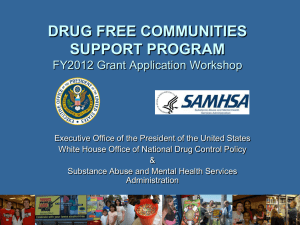Overview & Application Process for the Drug
advertisement
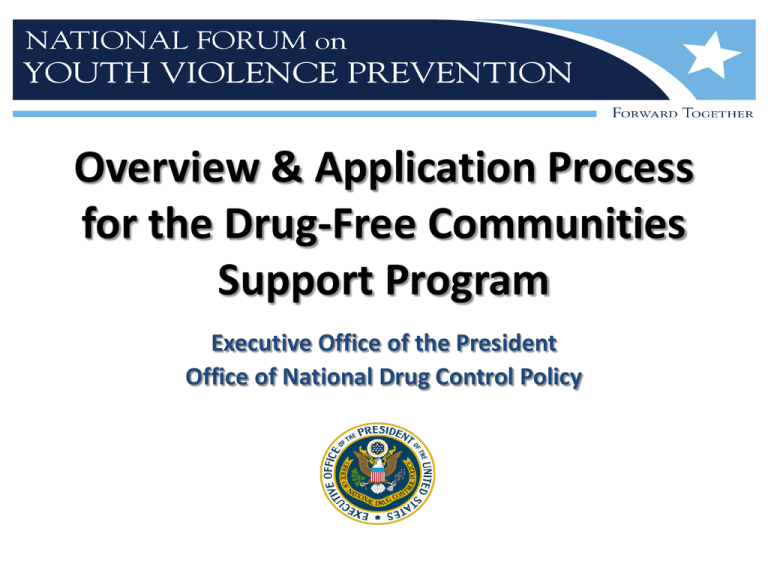
Overview & Application Process for the Drug-Free Communities Support Program Executive Office of the President Office of National Drug Control Policy Drug-Free Communities Act of 1997 • Established the DFC Program • Subsequent reauthorizations in 2001 and 2006 • Current reauthorization “in progress” • Funding for FY2013 is somewhere between $92 and 95million • • • Will fund around 100 grants next year Request for Applications posted in January 2013 All eligible coalitions are encouraged to apply Authorizes and Appropriates the DFC Program Office of National Drug Control Policy SAMHSA CADCA Review/Program/Finance Training/Technical Assistance DFC Grantees Goals of the DFC Program To establish and strengthen collaboration among communities, nonprofit agencies, and Federal, State, local and tribal governments to support the efforts of community coalitions to prevent and reduce substance use among youth To reduce substance use among youth and, over time, reduce substance abuse among adults by addressing the factors in a community that increase the risk of substance abuse and promoting the factors that minimize the risk of substance abuse Theory of the DFC Program A small amount of Federal funding combined with a local match of resources and volunteer support can reduce youth drug use – Grantees receive $125,000/year in 5 year cycles – Maximum of 10 years By mobilizing community leaders to identify and respond to the drug problems unique to their community, DFC is designed to change the entire community environment Focusing on environmental change ultimately contributes to reductions in substance use among youth, and over time, substance abuse among adults How DFC Works • Government issues Request for Applications • Coalitions apply • Applications are scored through a Peer Review process • Award highest scored applications until all funds are exhausted DFC’s Definition of a Coalition A formal arrangement for cooperation and collaboration between groups or sectors of a community, in which each group retains its identity, but all agree to work together toward a common goal of building a safe, healthy, and drug free community DFC grants are intended to support community-based coalitions Why Community Coalitions? • Local problems need local solutions • No one-size-fits-all way to solve problems • Communities needs to be able to adjust/adapt in real time • Efforts need to be owned by communities Facts About: FY 2012 DFC Grantees • • $92M appropriation funding 692 total grantees: • $84.6M to 692 DFC grantees • $2.8M to ONDCP (Administrative Operations) • $4.6M to SAMHSA (Grant Monitoring & Management) • $2M to CADCA (National Coalition Institute) DFC covers 49 states, DC, Puerto Rico, Palau, American Samoa and the Federated States of Micronesia DFC Works!!! • Past 30-day use of alcohol, tobacco & marijuana has declined for middle & high school • Past 30-day use of alcohol, tobacco & marijuana was lower for high school youth in DFCfunded communities than a nationally representative sample (YRBS data) ICF International, 2011 DFC Status Report DFC in Urban Centers • • • • Currently, 57% of all DFC grants are in urban centers $125k doesn’t seem like enough Big cities need multiple DFC coalitions Use the DFC Mentoring Program to get coalitions off the ground with the support of current DFC grantees • Help citizens understand that collaboration and leveraging of resources is the heart of coalition work • DFC is an infrastructure support grant—not intended to “buy” everything January RFA public February March March/April Applications Due HHS Format/Requirement Screening Recruit Peer Reviewers June/July Rank Order Funding Packages Assembled August Funding Decisions Announced May/June Peer Review Process April Statutory Eligibility Screening Eligible? Ineligible? September Notice of Awards Issued October Summary Sheets/Scores Mailed December Mandatory New Grantee Training in Washington, DC THE $625,000-$1,250,000 QUESTION IS…. WHY DO APPLICANTS FAIL TO GET FUNDED? The Simple Stuff • Do not miss application deadline • Aim for a week ahead of the deadline as your mail out date • Make sure you use the correct RFA…to the T • Not one from a previous year • Do not make up your own questions • Do not mix RFA questions • Some from one year and some from another • Follow the RFA for the correct year as it is written using all provided templates where REQUIRED The 12 Sectors (examples of potential representatives) • Youth • a person under 18; not a youth minister, coach, etc. • Parent • mother/father/guardian /grandparent • Business • Chamber of Commerce/owner of local business • Media • the outlet where the majority of the community gets information • School • Principal • Superintendent • Youth-Serving Organization • Boys & Girls Club The 12 Sectors (con’t) (examples of potential representatives) • Law Enforcement • Chief of Police/Sheriff • Religious/Fraternal Organizations • Pastor/Rabbi/Imam/ Masons • Civic/Volunteer Groups • Sertoma Club/Kiwanis Club/Big Brothers & Big Sisters • Not just a random “volunteer” on the coalition • Healthcare Professionals • Doctor/Nurse/Dentist/Behavi oral Health Professional • State/Local/Tribal Government w/ expertise in substance abuse prevention • SSA/State Prevention or Treatment Director • Other Substance Abuse Organization • Local prevention/treatment provider Statutory Eligibility Requirements: Coalition Minutes • Typically, the RFA asks for • One set between January 1-September 30 of the year PRIOR to the RFA being published • Second set from October 1 of the year PRIOR to the RFA being published and the application due date (March of the current year) • Purpose: • To prove 6 months existence, as well as recent coalition activity • To indicate significant involvement by sector members • To show that youth substance use prevention is a priority Statutory Eligibility Requirements: Mission Statement • Coalition must have as its principal mission the reduction of substance abuse, which at a minimum includes the prevention of the use/abuse of drugs…with a primary focus on youth… • Mission statement must belong to the applicant coalition • Problem - Mission statement is generalized toward public health issues Statutory Eligibility Requirements: Multiple Drugs • …developed a strategic plan to reduce substance abuse among youth, which targets multiple drugs of abuse • Multiple = more than 1 • Cannot be an “underage drinking” coalition that does not address other drugs • Do not use the terms “ATOD”, “substances” or “substance abuse” to account for all substances • List multiple drugs in data question and in the Action Plan Statutory Eligibility Requirements: National Evaluation Provide this information in the correct Attachment: 1. The name of the survey utilized to collect the survey for the four core measures. 2. How often/when will the survey(s) be administered for core measures data collection? – usually a year; tell us how often the survey is administered (yearly/every 2 years) 3. What, if any, supplemental survey(s)/data will be used to meet the requirements of the DFC National Cross-Site Evaluation? – Name of the survey/description of data or NA (if not applicable) Statutory Eligibility Requirements: Legally Eligibility Entity • Scenario One: • The coalition is it’s own 501(c) 3 and is legally eligible to apply for a DFC grant on its own • On a single sheet of paper, labeled “Attachment 5: Statement of Legally Eligibility Entity” • Write and sign a statement indicating the coalition is a legally eligibility entity Statutory Eligibility Requirements: Legally Eligibility Entity • Scenario Two: • The coalition is partnering with an outside agency to serve as the legal applicant/grantee on its behalf • May use the sample in the RFA for the Memorandum of Understanding between the partnering agency and the coalition • Must have two signatures: one from the legal applicant/grantee and one from the coalition Statutory Eligibility Requirements: Legally Eligible Entity • If the legal applicant (#8 on the 424) is not the coalition, then there must be an MOU signed between the legal applicant (#8 on the 424) and the coalition the grant, if awarded, will support • Even if the coalition is operated in the same building or under the same staffing structure as the legal applicant, an MOU must be in place between the legal applicant and the coalition Statutory Eligibility Requirements: 1:1 Match • Must indicate one-to-one match requirement • Problems: Incorrect math and/or forget to add match in the places indicated • Must show a dollar-for-dollar match from non-Federal sources equaling amount of Federal request • Know the origin of any funding you put forth as match (i.e., Is the police officer’s salary paid for with Federal funds passed through the State/County/City?) • Do not overpromise match • Must account for every matched dollar to the Government Statutory Eligibility Requirements: $125k/year • No more than $125,000/year within all parts of the application • Make sure ALL the numbers match • Make sure they do not exceed $125,000 Overlapping Zip Codes & Letter(s) of Mutual Cooperation • If an applicant coalition is going to overlap zip codes with a current DFC grantee or an applicant applying in the same cycle, the following must be included in a Letter of Mutual Cooperation: • Which zip codes overlap—list the specific zip codes • What the two (or more) coalitions will do to work together • Must have one signature from each overlapping coalition(s) on the letter One DFC Grant at a Time Grantee = Entity awarded a grant Coalition with 501c(3) status Outside Fiduciary Agent • Only one grant can be issued to a grantee at one time • Sign the form titled “Applicant Assurance of No More than One DFC Grant” and place under the correct Attachment number • This Appendix also states that you can only fund one coalition at a time. One grant, one coalition. End of Grant Policy (aka The 10 Year Rule) • Maximum of 10 years of DFC funding per coalition • Outside agencies acting as grantees on behalf of a coalition cannot seek funding for the same coalition for more than 10 years • Sign the form titled “Applicant Assurance of Compliance with the End of Grant Policy” and place under the correct Attachment number The Content: Project Narrative • Problem - Application contains fluff & not enough substance • Answer the question in the first 2-3 sentences of the first paragraph of the answer • Name your community—make it specific • “In the ABC neighborhood/town/city/county, local conditions increase the likelihood that youth substance use will take place….” • Do not write an application full of “obvious statements” • “Youth substance use is a problem that increases the opportunities for youth to fail at school and not become productive members of their community, and society as a whole.” The Content: Project Narrative • Problem - Application lacks consistent focus beginning with problem identification & throughout each question including the Action Plan • Example: Applicant lists underage drinking & Rx as main problems early in application, but fails to provide strategies to address underage drinking & Rx in Action Plan (or throughout application) • RFA has always contained a question that implies the use of data to determine the community’s most significant youth substance use problems • RFA will continue to ask for a 1-year Action Plan The Content: Project Narrative • Make the best use of the pages allotted for response to the Project Narrative • If a question has a high point value, it will most likely require more pages • The Action Plan will carry the most points in the RFA • Why? Because it tells us what you are going to do and what you want us to fund The Content: Project Narrative • Application lacks focus on environmental strategies • If you don’t know what “environmental strategies” are…learn • They are required for DFC grantees • Applications include strategies that are considered “environmental” will score higher • Action Plan should be comprehensive with a focus on environmental strategies Individual Provide information Build skills Provide support Change incentives / consequences Reduce barriers / enhance access Change physical design of the environment • Modify policies and broader systems Environmental • • • • • • The Content: Environmental Strategies • Seven Strategies for Community Change • Strategies 1-3=educational/individual • Strategies 4-7=environmental • Support the use of all 7 with emphasis of the use of DFC funding on strategies 4-7 • Newer coalitions may use 1-3 to prep a community for the implementation of 4-7 • New initiatives may require 1-3 to prep a community for the implementation of 4-7 The Content: Action Plan • MUST use the template as provided in the RFA • Must address BOTH DFC goals • May add your own in addition to the two indicated • Include measurable objectives • Include specific strategies that will move the objectives addressing the drugs named as priorities for the coalition • Must include activities relevant to each strategy for each drug being addressed Start Working on Your Action Plan TODAY! • • • • Please use Landscape Orientation 10 pt. font (ONLY IF USING PAPER SUBMISSION) Learn how to write a measureable objective Understand the difference between a “strategy” and an “activity” • Get technical assistance from the Institute (800-5422322, ext. 240) and have the Action Plan reviewed Reading/Using Old Applications • Do not waste your time reading old applications—even if they were funded • Do not dust off the one you wrote last year/the year before that/five years ago & submit it for the FY2013 RFA funding cycle • • • • RFA questions change every year purposefully The DFC Program evolves & changes We get smarter What was funded 1, 2, 3, 5 years ago might not get funded next year Who are Peer Reviewers? • DFC grantees in Years 1-4 or 6-10 or former grantees • Can include any member of the coalition • Go through training from ONDCP & SAMHSA • Want to read your “story” • Write application for one of your peers to read • Human elements to the process • Do not make it hard for Reviewers to find information • Lose the “fluff” • White space QUESTIONS? SHANNON WEATHERLY ACTING ADMINISTRATOR 202.395.6774 SWEATHERLY@ONDCP.EOP.GOV


